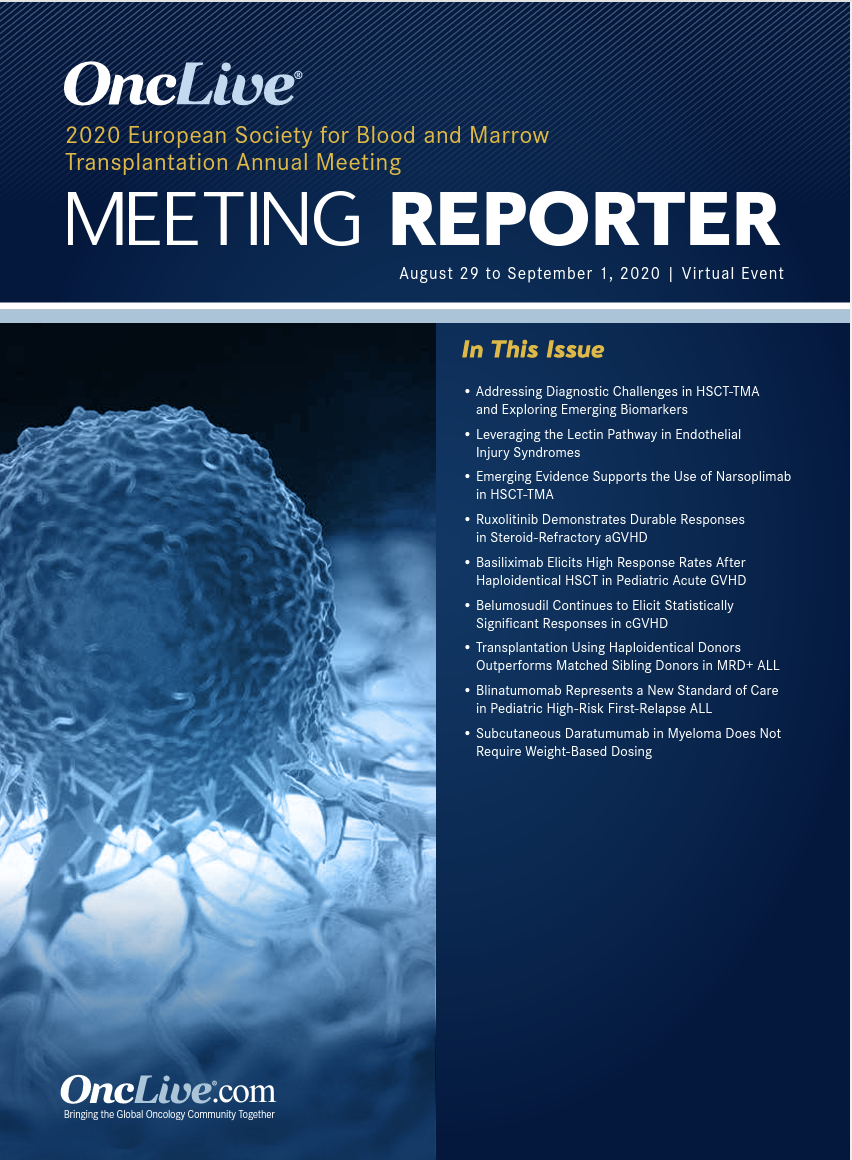Publication
Article
Supplements and Featured Publications
Ruxolitinib Demonstrates Durable Responses in Steroid-Refractory aGVHD
Author(s):
Ruxolitinib continued to elicit a significantly higher overall response rate compared with best available therapy at day 28 in patients with steroid-refractory acute graft-versus-host disease.
Robert Zeiser, MD

Ruxolitinib (Jakafi) continued to elicit a significantly higher overall response rate (ORR) compared with best available therapy (BAT) at day 28 in patients with steroid-refractory acute graft-versus-host disease (aGVHD), according to updated data from the pivotal phase 3 REACH2 trial (NCT02913261) presented during the 2020 European Society for Blood and Marrow Transplantation Annual Meeting.
“Ruxolitinib is the first novel agent to demonstrate superiority to BAT in a phase 3 trial of patients with steroid-refractory aGVHD,” said Prof. Robert Zeiser, MD, of University Hospital Freiburg, said in a presentation during the meeting.
Results showed that the ORR at day 28 was 62.3% with ruxolitinib versus 39.4% with BAT (odds ratio, 2.64; 95% CI, 1.65-4.22; P <.001) in this patient population, meeting the primary end point of the trial. Of those who responded to treatment, 34.4% of patients (n = 53) achieved a complete response (CR) in the ruxolitinib arm versus 19.4% of those in the BAT arm (n = 30); partial responses were reported in in 27.9% (n = 43) and 20.0% (n = 31) of patients, respectively.
Notably, the durable ORR at day 56 also proved to favor ruxolitinib compared with BAT, at 39.6% versus 21.9%, respectively (OR, 2.38; P = .0005). At this time, the CRs for ruxolitinib and BAT were 26.6% (n = 41) versus 16.1% (n = 25), respectively; PRs were 13.0% (n = 20) versus 5.8% (n = 9).
Moreover, ruxolitinib showed a consistent clinically meaningful benefit versus BAT across all of the different subgroups of baseline features, which included disease grade at randomization, organ involvement, criteria for steroid refractoriness, and transplant characteristics.
Additionally, the failure-free survival was also longer with ruxolitinib compared with BAT, at 5.0 months versus 1.0 month (HR, 0.46; 95% CI, 0.35-0.60).
In the randomized, open-label, multicenter phase 3 REACH2 trial, investigators set out to examine the safety and efficacy of ruxolitinib versus BAT as treatment for patients with steroid-refractory aGVHD. To be eligible for enrollment, patients had to be 12 years of age or older, had undergone an allogeneic hematopoietic stem cell transplantation, developed grade II-IV disease, and become refractory to corticosteroids.
In the trial, patients were randomized 1:1 to receive ruxolitinib at a starting dose of 10 mg twice daily or BAT per standard of care. Notably, crossover was allowed for patients on the BAT arm who did not achieve a response by day 28 or who lost a response thereafter. The primary end point of the trial was ORR at day 28, while key secondary end points included durable ORR at day 56, duration of response, and safety.
A total of 309 patients were randomized to receive either ruxolitinib (n = 154) or BAT (n = 155). Baseline characteristics were found to be well balanced between the 2 cohorts. The median age of participants was 54.0 years and more than half, or 59.2% were male. At the time of randomization, 34.3% of patients had grade II aGVHD, 46.3% had grade III disease, and 19.4% had grade IV disease.
With regard to safety, grade 3 or higher adverse effects (AEs) were reported through day 28 in 77.6% of those who received ruxolitinib versus 78.0% of those who were given BAT. The most commonly reported toxicities in the ruxolitinib and BAT arms included thrombocytopenia (27.0% vs 15.3%, respectively), anemia (21.7% vs 18.7%), reduced platelet count (14.5% vs 13.3%), and neutropenia (13.2% vs 9.3%). More patients on the ruxolitinib arm experienced infection compared with BAT, at 61.2% versus 54.7%, respectively; grade 3 infections were reported in 22.4% and 18.7% of patients, respectively.
Moreover, the most common cause of deaths while on treatment was aGVHD; 13.8% of patients on the investigational arm died (n = 21) versus 14.0% of those on the control arm (n = 21).
“We conclude from the study that the ORR at day 28 was significantly higher in the ruxolitinib group compared with BAT group. Ruxolitinib showed clinically meaningful treatment benefit and the ORR was durable, as [responses were] also seen on day 56,” concluded Zeiser. “The toxicity profile [of ruxolitinib] was consistent with what we expected for the agent and no unexpected safety concerns have been reported.”
Reference
Zeiser R, von Bubnoff N, Butler J, et al. Randomized phase 3 trial evaluating the efficacy and safety of ruxolitinib vs best available therapy in patients with steroid-refractory acute graft vs host disease (aGVHD). Presented at: 2020 European Society for Blood and Marrow Transplantation Annual Meeting; August 20-September 2, 2020; Virtual.










